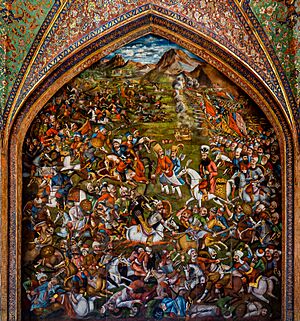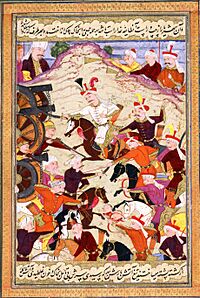Battle of Chaldiran facts for kids
Quick facts for kids Battle of Chaldiran |
|||||||||
|---|---|---|---|---|---|---|---|---|---|
| Part of the Ottoman–Persian Wars | |||||||||
 Artwork of the Battle of Chaldiran at the Chehel Sotoun Pavilion in Isfahan |
|||||||||
|
|||||||||
| Belligerents | |||||||||
| Commanders and leaders | |||||||||
| Strength | |||||||||
| 60,000 Or 100,000 100–150 cannon Or 200 cannon and 100 mortars |
40,000 Or 55,000 Or 80,000 |
||||||||
| Casualties and losses | |||||||||
| Heavy losses Or less than 2,000 |
Heavy losses Or approximately 5,000 |
||||||||
The Battle of Chaldiran was a major fight between two powerful empires: the Ottoman Empire and the Safavid Empire. It happened on August 23, 1514, on the Chaldiran plain. The Ottomans won a big victory. This battle was important because it stopped the Safavids from expanding west. It also led to the Ottomans taking control of Eastern Anatolia and northern Iraq.
This battle was just the start of a long, 41-year war between the two empires. This war finally ended in 1555 with the Treaty of Amasya. Even though the Safavids later got some lands back, they were permanently given to the Ottomans by the 1639 Treaty of Zuhab.
At Chaldiran, the Ottoman army was larger and had better weapons. They had between 60,000 and 100,000 soldiers, plus many heavy cannons. The Safavid army had about 40,000 to 80,000 soldiers but no cannons. Ismail I, the Safavid leader, was hurt and almost captured. His wives were taken by the Ottoman leader, Selim I. After this defeat, Ismail I was very sad and stopped leading his government or army. The Ottomans then marched into Persia, took over the Safavid capital, Tabriz, for a short time, and took many treasures.
This battle was very important in history. It showed that the leader of the Shia-Qizilbash was not unbeatable. It also caused Kurdish leaders to switch their loyalty from the Safavids to the Ottomans.
Why the Battle Happened
Rising Tensions Between Empires
Before the battle, Selim I became the leader of the Ottoman Empire. He had to fight his brothers for the throne. After winning, he focused on problems inside his empire. He believed these problems were caused by the Shia Qizilbash group.
The Qizilbash had supported Selim's brothers. They were also supported by the previous Ottoman leader, Bayezid II. Selim worried that the Qizilbash would turn people against him. He thought they would support Ismail I, the leader of the Safavids. Some of Ismail's followers even believed he was related to the Prophet.
Selim got advice from religious scholars. They said Ismail and the Qizilbash were "unbelievers." This allowed Selim to take strong actions as he moved his army east. He accused Ismail of not following the true faith.
Selim's Actions Before the Fight
Before starting his military campaign, Selim took harsh steps. He ordered the punishment of about 40,000 Qizilbash people in Anatolia. This was "for their rebellious behavior."
Selim also tried to stop Iranian silk from being sold in his empire. This plan had "some success." He then sent a letter to Ismail. In the letter, Selim claimed to be the true leader of all Muslims. He also said Ismail's beliefs were wrong.
Safavid Challenges and Ottoman March
While Selim was preparing, the Safavids faced another enemy in the east. The Uzbeks had recently become powerful. Their leader, Muhammad Shaybani, had been defeated by Ismail a few years earlier.
Ismail wanted to avoid fighting two wars at once. So, he used a "scorched earth" plan against Selim in the west. This meant his army destroyed food and water sources. They burned everything that the Ottoman army could use.
Selim's army became unhappy because of this. It was hard to find supplies. The land in the Armenian Highland was also very rough. The soldiers were also marching against other Muslims. At one point, the Janissaries, who were elite Ottoman soldiers, even shot their guns at Selim's tent to protest.
When Selim heard that the Safavid army was gathering at Chaldiran, he quickly moved to fight Ismail. He did this partly to stop his own army from being so unhappy.
The Battle Itself
The Ottomans had a strong battle plan. They placed their heavy cannons and thousands of Janissaries behind a wall of carts. The Janissaries were special soldiers who used gunpowder weapons like muskets.
The Safavids did not have cannons at Chaldiran. They used their cavalry, which were soldiers on horseback, to attack the Ottoman army. The Safavids tried to attack the sides of the Ottoman army to avoid the cannons in the middle.
But the Ottoman cannons could be moved easily. The Safavids suffered huge losses. The advanced Ottoman weapons, like cannons and muskets, were the main reason they won. The Safavid forces, who only had older, traditional weapons, were badly beaten. The Safavids also had poor planning and their soldiers were not as disciplined as the Ottomans.
What Happened After
After their victory, the Ottomans captured the Safavid capital city of Tabriz on September 7. They first took many valuable things from the city, then left it. For a week, the main religious speeches in the city's mosques were given in Selim's name.
However, Selim could not stay in Tabriz. His Janissary soldiers were still unhappy. The Ottoman Empire successfully took over Eastern Anatolia (which included parts of Western Armenia) and northern Mesopotamia from the Safavids. These areas changed hands many times over the next few decades. The Ottomans finally secured them with the 1555 Peace of Amasya treaty. Full control was not set until the 1639 Treaty of Zuhab.
Ismail was heartbroken after two of his wives and his entire family were captured by Selim. He lost his feeling of being unbeatable. Ismail stopped taking part in government and military matters. It seemed his confidence was completely gone.
Selim married one of Ismail's wives to an Ottoman judge. Ismail sent four messengers with gifts and kind words to Selim. He hoped to get his wife back. But Selim cut off the messengers' noses and sent them back without her.
After the defeat at Chaldiran, the Safavids made big changes. From then on, firearms became a key part of the Persian armies. Ismail's son, Tahmasp I, used cannons in later battles.
As the Ottoman troops left, Georgian cavalry from the Safavid army kept attacking them. They chased the Ottomans deep into their own lands.
The Mamluk Sultanate in Egypt refused to congratulate Selim after the battle. They also did not allow celebrations of the Ottoman victory. This was different from when the Ottomans took Constantinople, which led to days of parties in the Mamluk capital, Cairo.
After winning the Battle of Chaldiran, Selim I then moved his forces south. He fought the Mamluk Sultanate in the Ottoman–Mamluk War (1516–1517).
The Battlefield Today
The place where the battle happened is near Chala Ashaqi village. This is about 6 kilometers west of Siyah Cheshmeh town. It is south of Maku and north of Qareh Ziyaeddin. In 2003, a large brick dome was built at the battle site. A statue of Seyid Sadraddin, one of the main Safavid commanders, was also put there.
See also
- Shia–Sunni relations
- Ottoman–Safavid relations
- Sipahi




